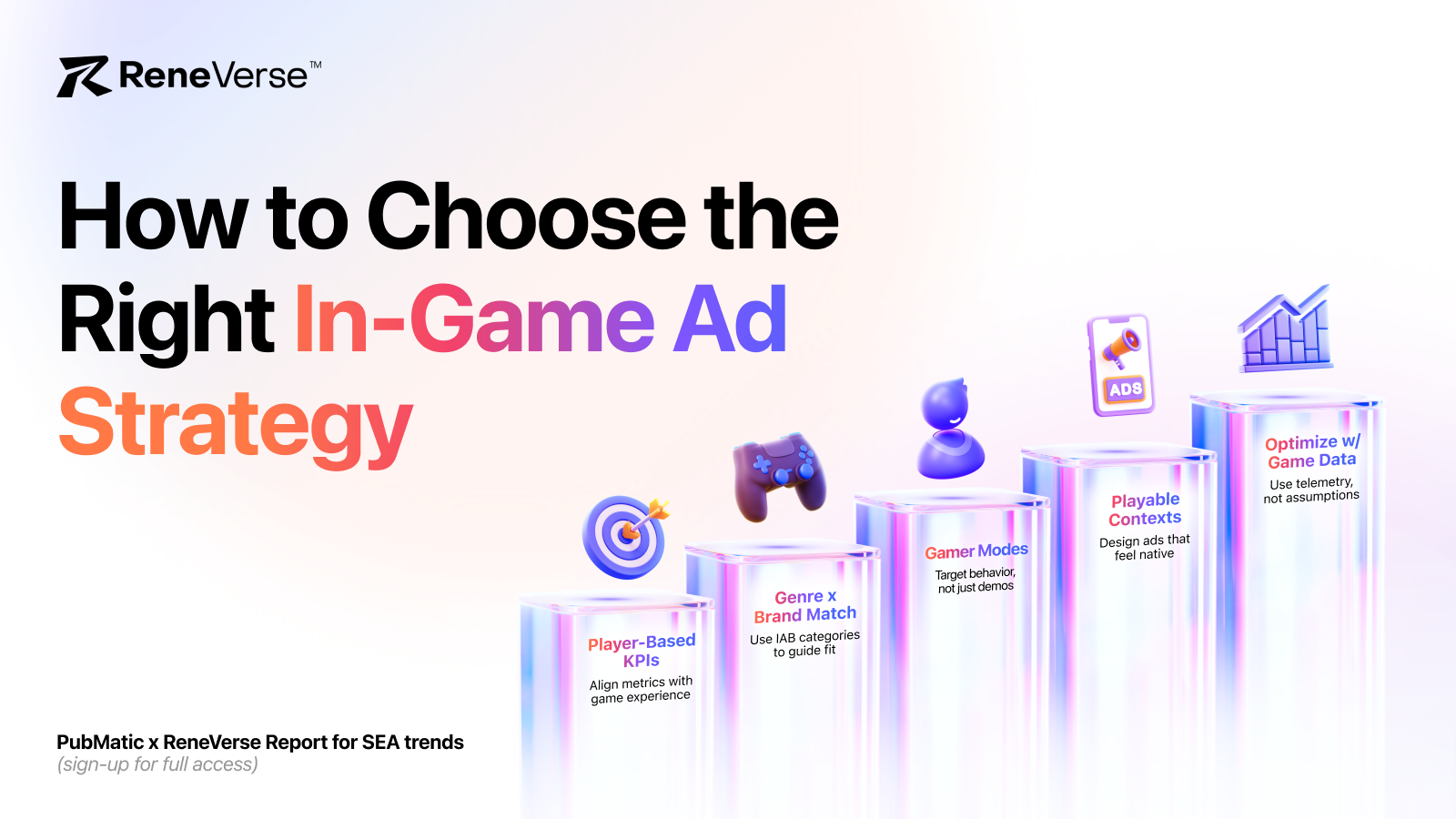How to Choose the Right Ad Strategy for Your Game

Build a Smarter In-Game Ad Strategy
Most in-game ad strategies sound great in theory. “Be seamless.” “Choose the right format.” But what does that actually mean in practice? And how do you turn those ideas into real performance?
Today’s gamers are savvier, more discerning—there’s no doubt that brands can no longer rely on generic placements or passive impressions to meet their expectations. To win attention and drive outcomes, you need a smarter, player-first approach that integrates ads into gameplay, not just screens.
To help you do just that, this blog introduces a 5-stage framework for building smarter in-game ad strategies. Whether you're a media buyer, gaming studio, or brand marketer, these steps will help you move from guesswork to game-ready execution.
And we’re not just guessing. These insights are grounded in findings from “Game On! The Key to Successful Mobile Game Advertising in Southeast Asia”, a gaming sentiment study we produced in partnership with PubMatic. Based on a survey of 1,000 mobile gamers across Thailand and the Philippines, the study offers a rare look into what players really think about ads, which formats they prefer, and where the biggest opportunities lie for your next in-game ad strategy.
1. Player-Based KPIs
Aligning metrics with game experience
The first step to building a smarter in-game ad strategy is measuring what truly matters. Traditional KPIs like impressions and clicks may work in static web environments—but in-game, they often miss the mark. Why? Because immersive worlds change how players perceive, interact with, and respond to branded content.
Rather than mapping performance to linear marketing funnels, align your KPIs to key moments in the player journey—from passive exposure to active engagement:
- For your Awareness stage, you can set KPIs in terms of % of players exposed to the ad in high-visibility, high-frequency areas (e.g., loading screens, arena signage)
- During the Consideration stage, measure time spent observing branded objects (e.g., interacting with a vehicle skin or product item)
- During the Engagement stage, you can measure brand awareness and loyalty through signals like repeat exposure and interaction(Note: while true retention is harder to influence directly through in-game ads, signals like repeat exposure and interaction can indicate meaningful brand lift over time)
What makes immersive formats especially effective is their ability to tap into emotional context. Players don’t just see an ad—they experience it within a world they’ve chosen to be part of. That emotional proximity drives deeper brand association and can influence post-game behavior.
Case in point: Our SEA research with PubMatic found that in-game ads drive 2x more product recommendations than TV (51% vs 27%). So while impressions may not capture the full impact, immersive formats clearly fuel organic brand amplification—especially when they align with the psychology of the player state.
Here’s how different in-game placements contribute to that:
- High-exposure formats like billboards and loading screens build recall and recognition, ideal for awareness plays.
- Branded objects and interactive elements create tactile familiarity, prompting curiosity and consideration.
- Contextual placements at high-agency moments (e.g., after a win or during progression milestones) spark positive brand associations that can convert to off-platform action.
📌 Smarter KPI mapping isn’t just about measurement—it’s about unlocking more meaningful outcomes.
Because when ads align with the player’s experience, they earn attention and create lasting impressions that go far beyond the impression itself.
2. Genre x Brand Match
Using IAB categories to guide fit
Not every brand belongs in every game. The best results happen when your brand aligns with game genre mechanics, player expectations, and visual tone.
Instead of guessing, use IAB content categories as a starting point to match your product category with the right game genres that share similar audience DNA.
For instance:
- Auto brands align naturally with racing or open-world adventure titles
- CPG brands thrive in casual, popular puzzle games (known as match-three games) with high-repeat gameplay loops
- Fashion brands pair well with lifestyle, simulation, sandbox or customization-heavy games
- Finance or home services align with management or building sim games
Use IAB category guidelines as a base, then refine by tone, visuals, and game rhythm. This ensures thematic relevance. From tone to gameplay rhythm, choose genres that enhance your brand rather than disrupt it.
📌 A well-matched genre isn’t just a good fit—it improves brand perception.
3. Gamer Modes
Targeting behavior, not just demographics
In-game advertising isn’t just about who the player is—it’s about how they play.
Our research with PubMatic found that 49% of high-income gamers feel positive about in-game ads, and 98% report feeling happy while playing. This emotional openness creates a powerful window for advertisers to connect—not through generic targeting like age or income, but through behavioral mindsets that drive gameplay.
You can come up with relevant gamer modes, or player archetypes, for your game—a way of segmenting players by their motivations and engagement styles, rather than static demographics. Here are some examples:
- Immersers: drawn to narrative, world-building, and emotional continuity
- Achievers: driven by goals, progression, and status
- Explorers: motivated by novelty, experimentation, and discovery
- Socializers: focused on community, cooperation, and shared experiences
Each mode responds to brand messaging differently. For example:
- Achievers may gravitate toward status-driven brands or performance-based products—especially in competitive gameplay contexts.
- Immersers may appreciate story-rich branded integrations that reinforce world-building.
- Explorers will respond best to surprise-and-delight experiences—think easter eggs, unique skins, or unexpected brand crossovers.
- Socializers are more likely to engage with customization or shareable formats, especially if they tie into identity or expression.
What’s key here is that these modes can shift dynamically depending on the game or moment. The same player might be a focused Achiever in a tactical shooter, then shift to a relaxed Socializer in a casual co-op game.
That’s why targeting mindsets over demographics leads to more resonant placements. Instead of trying to reach “males aged 18–34,” you’re speaking directly to the reasoning behind their gameplay behaviour.
📌 Behavioral targeting through Gamer Modes drives deeper emotional alignment, better timing, and stronger brand recall.
4. Playable Contexts
Designing ads that feel native to the game world.
“Seamless” doesn’t mean invisible—it means contextual. As we previously discussed (in our Genre x Brand Match section), the best in-game ads don’t just appear within the game; they make sense to the game.
Context takes into account the game’s genre and visual tone, the player’s mood and motivations, as well as the moment-to-moment gameplay flow. Ultimately, context ensures the right fit: does the brand feel natural in this moment, in this environment, with this player mindset?
Take this example: an energy drink ad on a racing pit billboard feels natural. That same ad dropped into a medieval quest? Jarring. The difference is contextual alignment—ensuring the message and brand belong in the narrative and visual language of the game world.
But while context is what makes an ad feel native, the format is how it is delivered—and that matters just as much.
In our study with PubMatic, we asked gamers across Southeast Asia how they felt about different in-game ad formats. The results were clear:
- 85% responded positively to in-game product placements
- 83% favored native ads that matched the game’s visual style
- 81% liked branded areas that blend into the game world
- 73% supported intrinsic in-game ads tied to gameplay mechanics
However, these highly favored formats are under-utilized. Only 21–27% of players had actually seen them in recent gameplay—revealing a big gap between what players prefer and what they experience.
This tells us: when the format blends into the environment and the context reinforces the story, players welcome the ad. They don’t just tolerate it—they see it as part of the world they’re immersed in.
📌 Context is the “why,” format is the “how.” Nail both, and your ad doesn’t interrupt—it enhances.
5. Optimize with Game Data
Use data measurement, not assumptions
In-game environments offer a level of telemetry, or data measurement, that most other channels can’t match—from heatmaps and pathing to dwell time and player inputs. Yet despite this rich dataset, many in-game ad strategies are still built on assumptions or outdated benchmarks.
That’s a missed opportunity.
To move from set-and-forget campaigns to adaptive performance loops, advertisers need to use real in-game data to guide decisions. Start by tracking:
- Ad exposure vs. engagement rates
- Player heatmaps to identify zones of attention or interaction
- Skip vs. complete rates for interactive formats
- Session length and playstyle patterns that impact ad receptiveness
With this data, you can iterate like a performance marketer:
- Place ads in areas where players naturally pause or focus
- A/B test creative formats across different genres or gameplay rhythms
- Adjust timing or frequency based on actual player behavior—not assumptions
This is where in-game advertising begins to evolve: from static insertion to live optimization. When you treat the game environment as a feedback loop, you unlock continuous performance gains without compromising the player experience.
📌 In-game telemetry gives you the tools—now use them to build smarter, more responsive campaigns that grow with your audience.
📃 Ready to Plan Smarter?
This guide breaks the process into five clear stages—each designed to move your ad strategy from intuitive to intelligent, and from exposure to engagement. Whether you're a media buyer, brand lead, or gaming studio looking to monetize, this framework gives you a smarter, player-first path to impact.
Access the Full Report: PubMatic x ReneVerse SEA In-Game Advertising Study
Curious to see how top advertisers are approaching their SEA in-game ad strategy in 2025? Download our joint study for the latest trends, benchmarks, and insights:
- Creative performance data
- Region-specific behavior trends
- Benchmarks across formats and genres
- Brand safety insights
With data-backed insights on gamer sentiment, ad effectiveness, and media habits, this report offers a clear playbook for advertisers and developers looking to win in the attention economy.
📥 Download the full ‘Game On!’ research report for free (just an email required) to dive deeper into the trends, stats, and strategic insights.
📞 Connect with our team to explore ReneVerse in-game ad solutions, start building your in-game ad strategy and explore high-impact ad formats that resonate with players.

